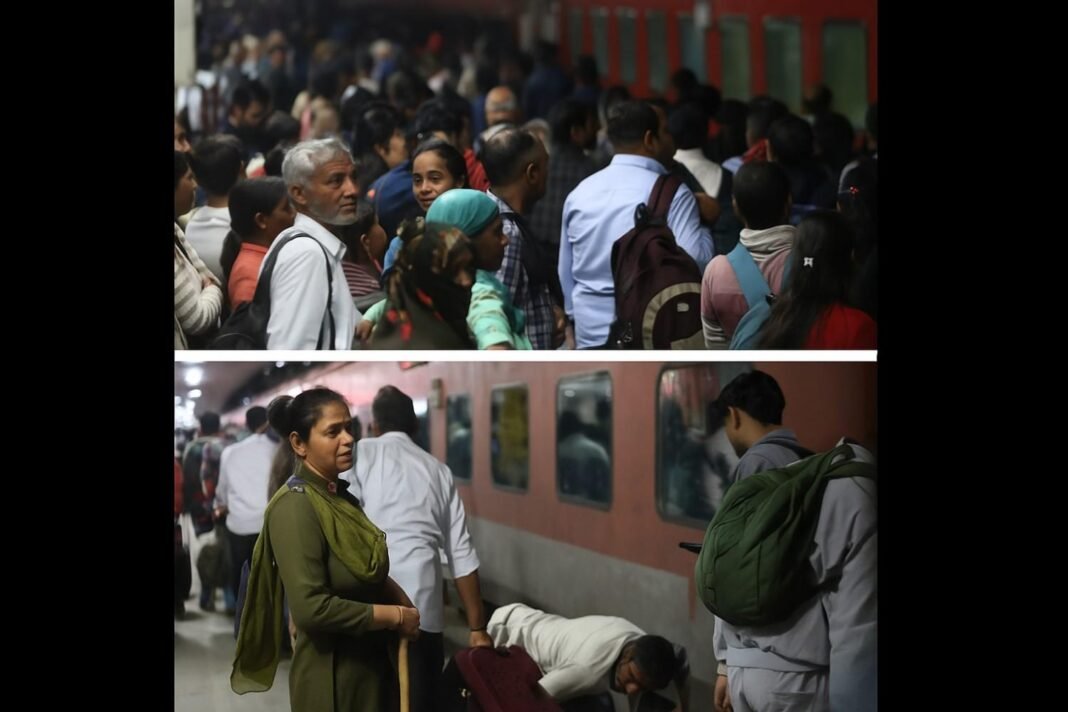Luggage Mishap Sparked Fatal Stampede at New Delhi Station
A tragic stampede that killed 18 people at New Delhi railway station in February was triggered by a single piece of luggage that fell from a passenger’s head, Union Railways Minister Ashwini Vaishnaw informed Parliament on Friday. The high-level inquiry into the incident revealed that the luggage drop led to a chain reaction of panic and tripping on an overcrowded foot-over-bridge, culminating in one of India’s deadliest railway station incidents in recent years.
The stampede occurred on February 15 during peak evening hours, around 8:48 pm, as thousands of passengers thronged the station en route to Bihar, amid the massive Maha Kumbh gathering in Prayagraj. The chaos unfolded on Foot-Over-Bridge (FOB) 3, which connects platforms 14 and 15, as crowds surged toward the departing trains.
According to the minister’s reply to a written question from Samajwadi Party MP Ramji Lal Suman, the mishap was set off by a headload—a large item being carried on the head—that slipped and fell onto the densely packed footbridge. The falling luggage triggered a ripple effect of pushing and tripping among passengers, many of whom were also carrying heavy baggage.
Victims and Findings
Among the 18 victims were 11 women and 4 children. Post-mortem reports confirmed that the cause of death for all was traumatic asphyxia, a condition resulting from intense compression and lack of oxygen.
The official inquiry found that although crowd management measures were technically in place, they were not sufficient to handle the sheer volume of passengers. The situation worsened between 8:15 pm and 8:45 pm as unreserved ticket sales soared—over 7,600 such tickets were sold that evening, at a rate of 1,500 per hour from 6 pm onward.
The 25-foot-wide footbridge was unable to handle the congestion, particularly with many passengers balancing heavy loads on their heads, further obstructing the flow of movement. Officials have since called the incident “completely avoidable” and an outcome of poor real-time management.
Railways’ Plan for Overhaul
In response to the tragedy and the subsequent backlash, Indian Railways has announced a comprehensive overhaul of its crowd control infrastructure across 73 stations identified as vulnerable to overcrowding. These include major transit hubs such as Varanasi, Ayodhya, Ghaziabad, Anand Vihar, and New Delhi.
The plan involves implementing full access control systems at these stations. Entry will be limited to passengers with confirmed reservations, while those without confirmed seats or with general tickets will be held in designated waiting zones outside the station until their trains arrive. All unauthorized access points will be sealed to prevent overcrowding within platform areas.
Infrastructure and Technology Upgrades
As part of the overhaul, the railways will construct wider foot-over-bridges—ranging from 6 to 12 meters wide—replacing older, narrower designs. These improved bridges, already tested during the Mahakumbh, include ramps for easier mobility and faster dispersal of crowds.
Surveillance will also be enhanced through high-resolution CCTV networks and dedicated command “war rooms” to monitor crowd patterns in real time. Additionally, digital communication tools such as public address systems, walkie-talkies, and LED-based crowd guidance mechanisms will be installed at all identified stations.
Station Management Reforms
To ensure quick decision-making during peak rush hours or emergencies, each major station will have a designated station director. This senior officer will have full financial and administrative authority, with all departments reporting directly to them. Ticket sales will also be regulated based on real-time platform capacity and train availability.
Staff members at these stations will receive distinctive uniforms and identification badges to prevent unauthorized personnel from operating within restricted areas.
Minister Vaishnaw emphasized that these steps aim to ensure passenger safety and prevent avoidable tragedies like the February stampede. While the reforms will take time to roll out in full, pilot projects are already underway at select stations.
The New Delhi stampede has drawn parallels with the 2017 Elphinstone Road incident in Mumbai, where 23 people lost their lives. Officials and experts alike have stressed that with proper preventive measures, such disasters can and must be averted.








